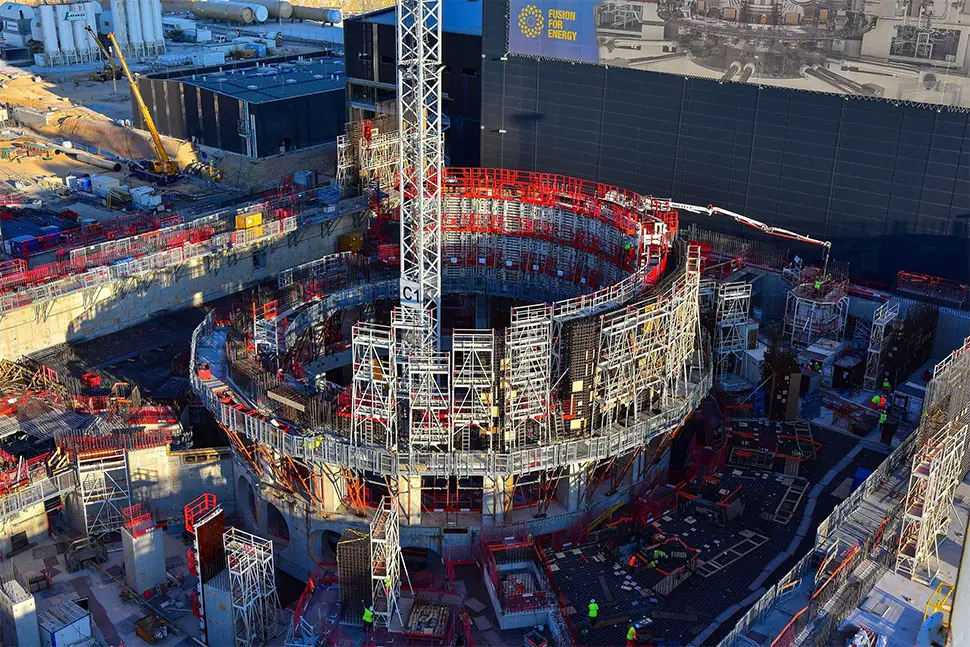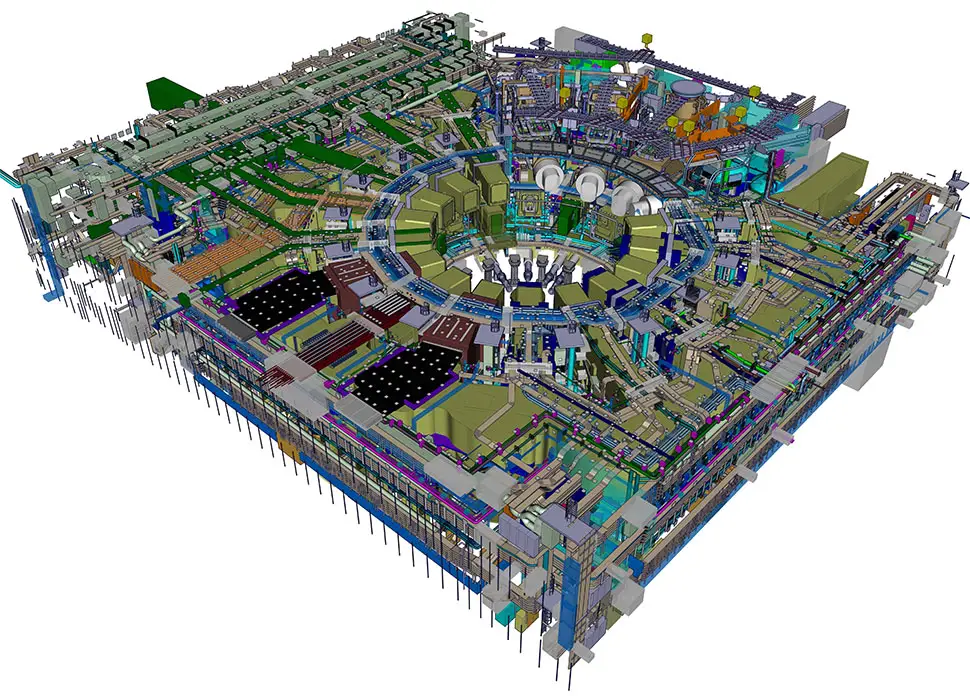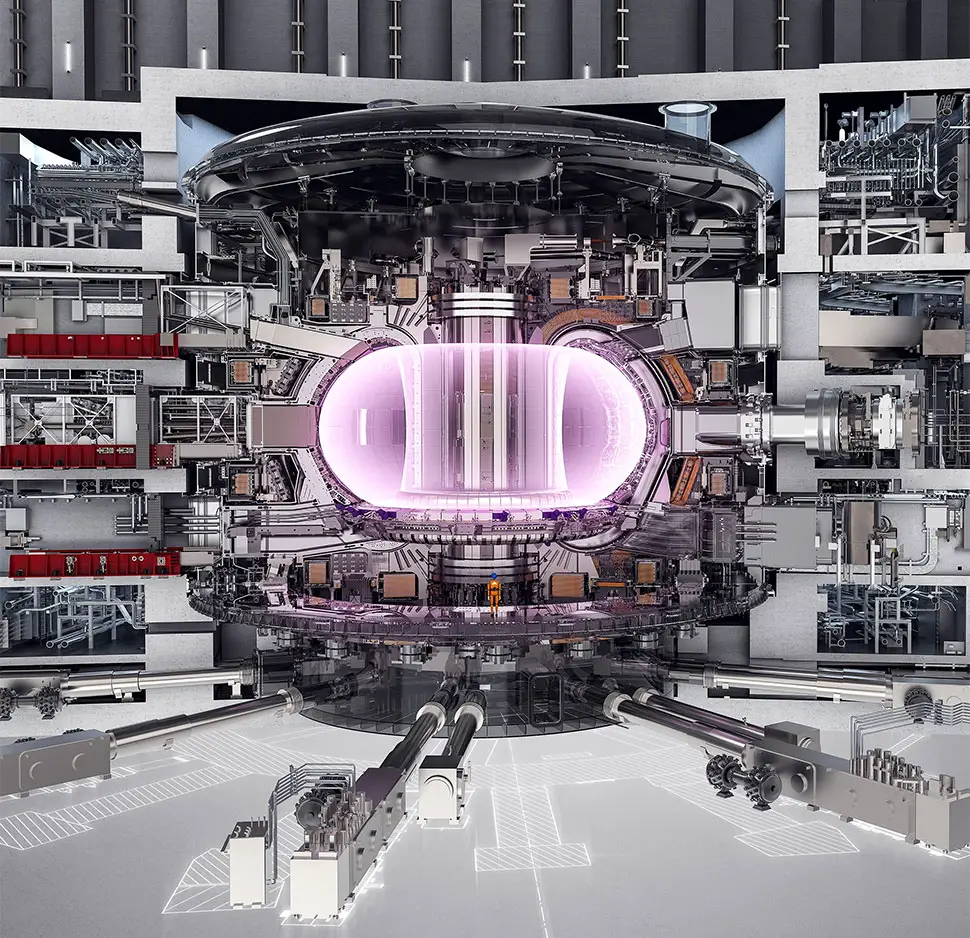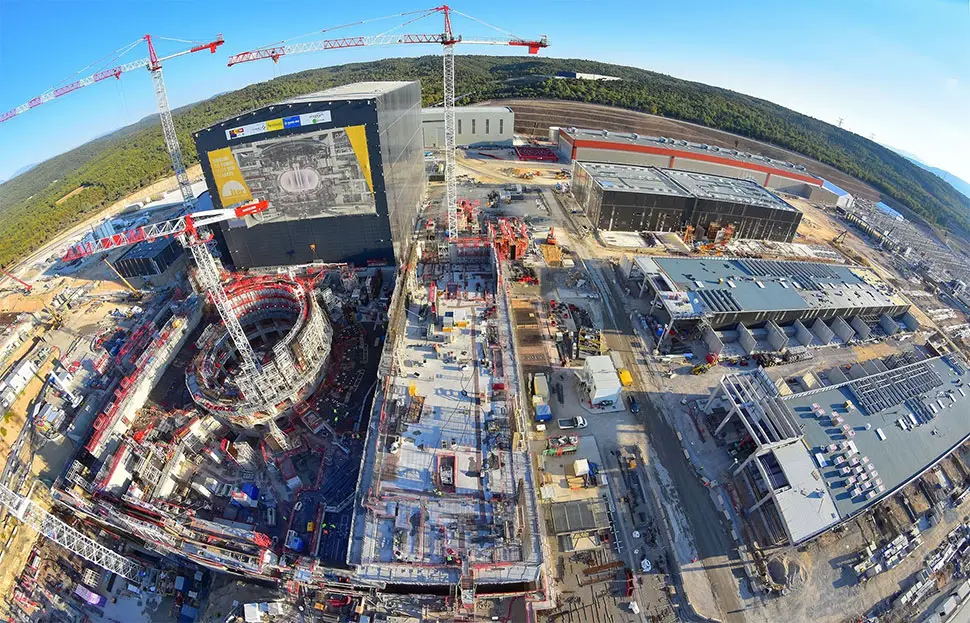
8th December 2017 ITER fusion reactor is 50% complete Construction of the ITER fusion reactor – described as the most complex machine in human history – has reached the halfway point.
The International Thermonuclear Experimental Reactor (ITER), a project to demonstrate that fusion power can be produced on a commercial scale and is sustainable, is now 50 percent built to initial operation. ITER will use hydrogen fusion, controlled by superconducting magnets, to create massive heat energy. In the commercial machines that follow, this heat will drive turbines to produce electricity with a number of major benefits:
ITER is the most complex science project in human history. The hydrogen plasma will be heated to 150 million degrees Celsius, ten times hotter than the core of the Sun, to enable the fusion reaction. The process happens in a donut-shaped reactor, called a tokamak, surrounded by giant magnets that confine and circulate the superheated, ionized plasma, away from the metal walls. The superconducting magnets must be cooled to minus 269°C, as cold as interstellar space. The ITER facility is being built in southern France by a scientific partnership of 35 countries. ITER has specialised components, roughly 10 million parts in total, being manufactured in industrial facilities all over the world. They are subsequently shipped to the ITER worksite, where they must be assembled, piece-by-piece, into the final machine. Each of the seven ITER members – the European Union, China, India, Japan, Korea, Russia, and the United States – is fabricating a significant portion of the machine. This adds to ITER’s complexity.
In a message sent to top-level officials in ITER member governments, the ITER Project reports that it has completed 50 percent of the “total construction work scope through First Plasma”. Scheduled for December 2025, “First Plasma” will be the first stage of operation for ITER as a functional machine. “The stakes are very high for ITER,” writes Bernard Bigot, Ph.D., Director-General of ITER. “When we prove that fusion is a viable energy source, it will eventually replace burning fossil fuels, which are non-renewable and non-sustainable. Fusion will be complementary with wind, solar, and other renewable energies. “ITER’s success has demanded extraordinary project management, systems engineering, and almost perfect integration of our work. “Our design has taken advantage of the best expertise of every member’s scientific and industrial base. No country could do this alone. We are all learning from each other, for the world’s mutual benefit.” The ITER 50 percent milestone is getting significant attention. “We are fortunate that ITER and fusion has had the support of world leaders, historically and currently,” Bigot continues. “The concept of the ITER Project was conceived at the 1985 Geneva Summit between Ronald Reagan and Mikhail Gorbachev. When the ITER Agreement was signed in 2006, it was strongly supported by leaders such as French President Jacques Chirac, US President George W. Bush, and Indian Prime Minister Manmohan Singh. “More recently, President Macron and US President Donald Trump exchanged letters about ITER after their meeting this past July. One month earlier, President Xi Jinping of China hosted Russian President Vladimir Putin and other world leaders in a showcase featuring ITER and fusion power at the World EXPO in Astana, Kazakhstan. “We know that other leaders have been similarly involved behind the scenes. It is clear that each ITER member understands the value and importance of this project.”
More than 80 percent of ITER's cost, about $22 billion or €18 billion, is contributed in the form of components manufactured by the partners. Many of these massive components must be fitted with high precision – for example, 17-metre-high magnets with less than a millimetre of tolerance. Each component must be ready on time to fit into the Master Schedule for machine assembly. Members asked for this deal for three reasons. First, it means that most of the ITER costs paid by any Member are actually paid to that Member’s companies; the funding stays in-country. Second, the companies working on ITER build new industrial expertise in major fields – such as electromagnetics, cryogenics, robotics, and materials science. Third, this new expertise leads to innovation and spin-offs in other fields. For example, expertise gained working on ITER’s superconducting magnets is now being used to map the human brain with more detail than ever before. The European Union is paying 45 percent of the cost; China, India, Japan, Korea, Russia, and the United States each contribute 9 percent equally. All members share in the technology; they receive equal access to the intellectual property and innovation that comes from building ITER.
ITER scientists predict that fusion plants could start to come on line as soon as 2040. The exact timing, according to fusion experts, will depend on the level of public urgency and political will that translates to financial investment. The ITER tokamak will produce 500 megawatts (MW) of thermal power. This size is suitable for studying a “burning” or largely self-heating plasma, a state of matter that has never been produced in a controlled environment on Earth. In a burning plasma, most of the plasma heating comes from the fusion reaction itself. Studying the fusion science and technology at ITER’s scale will enable optimisation of the plants that follow. A commercial fusion plant will be designed with a slightly larger plasma chamber, for 10-15 times more electrical power. A 2,000-MW fusion electricity plant, for example, would supply two million homes. The initial capital cost of a 2,000-MW fusion plant would be in the range of $10 billion. These capital costs will be offset by extremely low operating costs, negligible fuel costs, and infrequent component replacement costs over the 60-year-plus life of the plant. Capital costs will decrease with large-scale deployment of fusion plants. At current electricity usage rates, one fusion plant would be more than enough to power a city the size of Washington, D.C. The entire D.C. metropolitan area could be powered with four fusion plants, with zero carbon emissions. “If fusion power becomes universal, the use of electricity could be expanded greatly, to reduce the greenhouse gas emissions from transportation, buildings and industry,” predicts Dr. Bigot. “Providing clean, abundant, safe, economic energy will be a miracle for our planet.”
Comments »
If you enjoyed this article, please consider sharing it:
|










